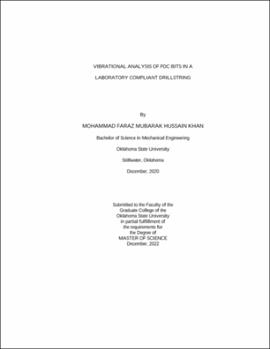| dc.contributor.advisor | Al Dushaishi, Mohammed F. | |
| dc.contributor.author | Mubarak Hussain Khan, Mohammad Faraz | |
| dc.date.accessioned | 2023-08-02T19:47:15Z | |
| dc.date.available | 2023-08-02T19:47:15Z | |
| dc.date.issued | 2022-12 | |
| dc.identifier.uri | https://hdl.handle.net/11244/338802 | |
| dc.description.abstract | Excessive vibrations during drilling operations can shorten the life of downhole equipment and instruments. One of the major contributors to drilling vibrations is bit-rock interaction. Therefore, controlling drillstring vibrations increases the range of drilling operating parameters to maintain a safe drilling operation. The goal of the research is to study the effect of drillstring vibration on drill bit dynamics and to estimate the frictional parameters of various bit-rock interaction models using laboratory testing data. In collaboration with Sandia National Laboratory (SNL), drilling tests in a controlled laboratory environment with multiple drillstring configurations mimicking field drillstring vibrations were performed at the Hard Rock Drilling Facility (HRDF). The rigid configuration was used as a base case to compare the effect of drillstring vibration on drill bit dynamics. The various drillstring configurations were investigated using two 3¾ inches of Polycrystalline Diamond Compact (PDC) bits with 4 and 5-blade designs. Drilling tests were conducted at 500 lb axial load increments up to 5500 lb at three constant rotating speeds of 80, 120, and 160 RPM. The results showed that the flywheel configuration provides a stable torque to the bit, while the torsional compliance configuration produced less torque at the same weight on bit (WOB) compared to the rigid configuration for the 4-bladed bit. The axial compliance configuration increases the WOB variation. The combined axial torsional compliance configuration showed increased fluctuation in WOB, rotational speed, and applied torque. Overall, traditional rigid drillstring experiments overestimate drilling vibrations frequencies by an average of 26.3% in the axial direction and 35% in the torsional direction when compared to the combined axial and torsional compliance for both bit designs. The use of the 5-bladed PDC bit in hard rock reduces axial vibrations by 53.7% in the axial direction and 14.2% in the torsional direction. The drilling test data were compared with one coupled axial and torsional bit-rock interaction model, and three uncoupled torsional bit-rock interaction models to perform a sensitivity analysis and determine the frictional constants for the testing data. The sensitivity of models showed difficulties in predicting actual laboratory conditions where such models are highly dependent on the frictional constants which are difficult to obtain for a certain drilling condition. | |
| dc.format | application/pdf | |
| dc.language | en_US | |
| dc.rights | Copyright is held by the author who has granted the Oklahoma State University Library the non-exclusive right to share this material in its institutional repository. Contact Digital Library Services at lib-dls@okstate.edu or 405-744-9161 for the permission policy on the use, reproduction or distribution of this material. | |
| dc.title | Vibrational analysis of PDC bits in a laboratory compliant drillstring | |
| dc.contributor.committeeMember | Bikkina, Prem | |
| dc.contributor.committeeMember | Lee, Hunjoo | |
| osu.filename | MubarakHussainKhan_okstate_0664M_17893.pdf | |
| osu.accesstype | Open Access | |
| dc.type.genre | Thesis | |
| dc.type.material | Text | |
| dc.subject.keywords | bit dynamics | |
| dc.subject.keywords | bit-rock interaction | |
| dc.subject.keywords | compliant drillstring | |
| dc.subject.keywords | frequency analysis | |
| dc.subject.keywords | PDC bits | |
| dc.subject.keywords | vibration | |
| thesis.degree.discipline | Petroleum Engineering | |
| thesis.degree.grantor | Oklahoma State University | |
